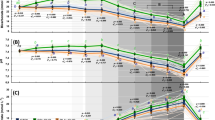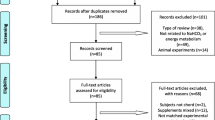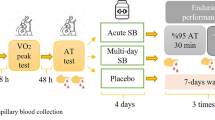Abstract
Lactate (La) and H+-ions are unequally distributed in the blood between plasma and red blood cells (RBCs). To our knowledge there is no data concerning the effects of an oral ingestion of bicarbonate (HCO3 −) on repeated high intensity sprint exercise and La and H+ distribution between plasma and RBCs. Since an oral ingestion of HCO3 − leads to a higher efflux of La from the working skeletal muscle to the plasma, as it was shown by previous studies, this would lead to a higher gradient of La between plasma and RBCs. Although a higher gradient leads to a higher uptake, it is even more difficult for the RBCs to take up La fast enough, due to the more stressed transport system. Since RBCs function to transport La from the working muscle and help to maintain a concentration difference between plasma and muscle, this potentially increases performance during repeated sprint exercise (e.g. 4 × 30 s). The major goal of the present investigation was to test this hypothesis. 11 male participants ingested either a solution of sodium bicarbonate (NaHCO3) or placebo (CaCO3). Thereafter all performed four maximal 30 s sprints with 5 min of passive rest. During the resting periods concentrations of HCO3 −, La and H+ where measured in both blood compartments (plasma and RBCs). There were no significant differences in the La-ratios between plasma and RBCs between both interventions. These results indicate that the La/H+ co-transport is not affected by an oral ingestion on NaHCO3.




Similar content being viewed by others
References
Artioli GG, Gualano B, Coelho DF, Benatti FB, Gailey AW, Lancha AH Jr (2007) Does sodium-bicarbonate ingestion improve simulated judo performance? Int J Sport Nutr Exerc Metab 17(2):206–217
Bishop D, Claudius B (2005) Effects of induced metabolic alkalosis on prolonged intermittent-sprint performance. Med Sci Sports Exerc 37(5):759–767
Bishop D, Edge J, Davis C, Goodman C (2004) Induced metabolic alkalosis affects muscle metabolism and repeated-sprint ability. Med Sci Sports Exerc 36(5):807–813
Böning D, Klarholz C, Himmelsbach B, Hutler M, Maassen N (2007) Causes of differences in exercise-induced changes of base excess and blood lactate. Eur J Appl Physiol 99(2):163–171
Brugnara C (1997) Erythrocyte membrane transport physiology. Curr Opin Hematol 4(2):122–127
Cerretelli P, Samaja M (2003) Acid-base balance at exercise in normoxia and in chronic hypoxia. Revisiting the “lactate paradox”. Eur J Appl Physiol 90(5–6):431–448
Cohen J (1988) Statistical power analysis for the behavioral sciences. Lawrence Erlbaum Associates, Hillsdale, NJ
Coles L, Litt J, Hatta H, Bonen A (2004) Exercise rapidly increases expression of the monocarboxylate transporters MCT1 and MCT4 in rat muscle. J Physiol 561(Pt 1):253–261
Costill DL, Verstappen F, Kuipers H, Janssen E, Fink W (1984) Acid-base balance during repeated bouts of exercise: influence of HCO3. Int J Sports Med 5(5):228–231
Deuticke B (1982) Monocarboxylate transport in erythrocytes. J Membr Biol 70(2):89–103
Dill DB, Costill DL (1974) Calculation of percentage changes in volumes of blood, plasma, and red cells in dehydration. J Appl Physiol 37(2):247–248
Foxdal P, Sjodin B, Rudstam H, Ostman C, Ostman B, Hedenstierna GC (1990) Lactate concentration differences in plasma, whole blood, capillary finger blood and erythrocytes during submaximal graded exercise in humans. Eur J Appl Physiol Occup Physiol 61(3–4):218–222
Gladden LB (2004) Lactate metabolism: a new paradigm for the third millennium. J Physiol 558(Pt 1):5–30
Gladden LB, Smith EW, Skelton MS (1994) Lactate distribution in blood during passive and active recovery after intense exercise. Med Sci Sports Exerc Supplement 26(5):s35
Hildebrand A, Lormes W, Emmert J, Liu Y, Lehmann M, Steinacker JM (2000) Lactate concentration in plasma and red blood cells during incremental exercise. Int J Sports Med 21(7):463–468
Hood VL, Schubert C, Keller U, Muller S (1988) Effect of systemic pH on pHi and lactic acid generation in exhaustive forearm exercise. Am J Physiol 255(3 Pt 2):F479–F485
Inbar O, Bar-Or O, Skinner J (1996) The Wingate Anaerobic Test. Human Kinetics Champaign, IL, pp 25–40
Jones NL, Sutton JR, Taylor R, Toews CJ (1977) Effect of pH on cardiorespiratory and metabolic responses to exercise. J Appl Physiol 43(6):959–964
Juel C (1997) Lactate-proton cotransport in skeletal muscle. Physiol Rev (2):321–358
Juel C, Bangsbo J, Graham T, Saltin B (1990) Lactate and potassium fluxes from human skeletal muscle during and after intense, dynamic, knee extensor exercise. Acta Physiol Scand 140(2):147–159
Juel C, Lundby C, Sander M, Calbet JA, Hall G (2003) Human skeletal muscle and erythrocyte proteins involved in acid-base homeostasis: adaptations to chronic hypoxia. J Physiol 548(Pt 2):639–648
Lindh AM, Peyrebrune MC, Ingham SA, Bailey DM, Folland JP (2008) Sodium bicarbonate improves swimming performance. Int J Sports Med 29(6):519–523
Lindinger MI, McKelvie RS, Heigenhauser GJ (1995) K+ and Lac- distribution in humans during and after high-intensity exercise: role in muscle fatigue attenuation? J Appl Physiol 78(3):765–777
McKelvie RS, Lindinger MI, Heigenhauser GJ, Jones NL (1991) Contribution of erythrocytes to the control of the electrolyte changes of exercise. Can J Physiol Pharmacol 69(7):984–993
McNaughton LR (1992a) Bicarbonate ingestion: effects of dosage on 60 s cycle ergometry. J Sports Sci 10(5):415–423
McNaughton LR (1992b) Sodium bicarbonate ingestion and its effects on anaerobic exercise of various durations. J Sports Sci 10(5):425–435
McNaughton LR, Siegler J, Midgley A (2008) Ergogenic effects of sodium bicarbonate. Curr Sports Med Rep 7(4):230–236
Merezhinskaya N, Fishbein WN (2009) Monocarboxylate transporters: past, present, and future. Histol Histopathol 24(2):243–264
Roth DA (1991) The sarcolemmal lactate transporter: transmembrane determinants of lactate flux. Med Sci Sports Exerc 23(8):925–934
Roth DA, Brooks GA (1990) Lactate and pyruvate transport is dominated by a pH gradient-sensitive carrier in rat skeletal muscle sarcolemmal vesicles. Arch Biochem Biophys 279(2):386–394
Sara F, Hardy-Dessources MD, Marlin L, Connes P, Hue O (2006) Lactate distribution in the blood compartments of sickle cell trait carriers during incremental exercise and recovery. Int J Sports Med 27(6):436–443
Siegler JC, Keatley S, Midgley AW, Nevill AM, McNaughton LR (2008) Pre-exercise alkalosis and acid-base recovery. Int J Sports Med 29(7):545–551
Skelton MS, Kremer DE, Smith EW, Gladden LB (1998) Lactate influx into red blood cells from trained and untrained human subjects. Med.Sci.Sports Exerc (4):536–542
Smith EW, Skelton MS, Kremer DE, Pascoe DD, Gladden LB (1997) Lactate distribution in the blood during progressive exercise. Med Sci Sports Exerc 29(5):654–660
Smith EW, Skelton MS, Kremer DE, Pascoe DD, Gladden LB (1998) Lactate distribution in the blood during steady-state exercise. Med Sci Sports Exerc 30(9):1424–1429
Stephens TJ, McKenna MJ, Canny BJ, Snow RJ, McConell GK (2002) Effect of sodium bicarbonate on muscle metabolism during intense endurance cycling. Med Sci Sports Exerc 34(4):614–621
Wahl P, Zinner C, Yue Z, Bloch W, Mester J (2010) Warming-up affects performance and lactate distribution between plasma and red blood cells. J Sports Sci Med 9 (in press)
Yunoki T, Matsuura R, Arimitsu T, Kimura T, Yano T (2009) Effects of sodium bicarbonate ingestion on hyperventilation and recovery of blood pH after a short-term intense exercise. Physiol Res 58(4):537–543
Author information
Authors and Affiliations
Corresponding author
Additional information
Communicated by Susan A. Ward.
Rights and permissions
About this article
Cite this article
Zinner, C., Wahl, P., Achtzehn, S. et al. Effects of bicarbonate ingestion and high intensity exercise on lactate and H+-ion distribution in different blood compartments. Eur J Appl Physiol 111, 1641–1648 (2011). https://doi.org/10.1007/s00421-010-1800-4
Received:
Accepted:
Published:
Issue Date:
DOI: https://doi.org/10.1007/s00421-010-1800-4




